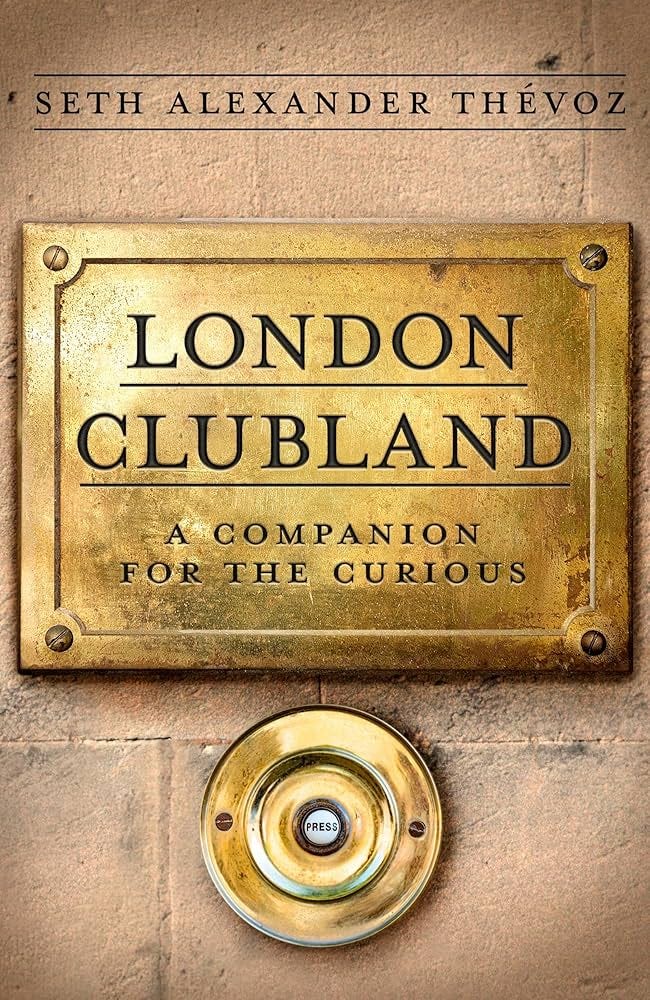All About England
Clubland USA takes a gander across the pond

England is one of the most fascinating places in the world, especially if you have an affinity for club life. Dare I say, if you’re a true club cat, one must treat a trip to England as a pilgrimage.
We’ve heard the many variations of the jokes about Brits in clubs. A personal favorite goes as follows:
An Englishman decided to start a club for people who appreciate the quiet life. The first rule was: No loud noises. The second rule was: Absolutely no whistling. The third rule was: If you must speak, do so in a whisper. On the first day, a potential member arrived and cleared his throat. The Englishman politely but firmly asked him to leave.
If you ultimately make the pilgrimage and find yourself in London, one must not leave home without a copy of Seth Alexander Thevoz’s London Clubland: A Companion for the Curious. Below, you will find a review of Thevoz’s work, published earlier this summer, written by yours truly.
Chatter, which has been reimagined as a Clubland USA mini-podcast, features Ishaan Jajodia in an episode titled, “Ties and Titles”. In this episode, Ishaan brings his personal observations of the similarities and differences between American Clubland and British Clubland.
Dispatches are brought to you by Ishaan Jajodia. —LR
A Fun Jaunt through London Clubland
Seth Alexander Thévoz, London Clubland: A Companion for the Curious
Little, Brown Book Group. $27
The six words of the title was my first reaction upon closing Seth Thevoz’s London Clubland: A Companion for the Curious. To read this work was as delightful as the first bite of a club fry.
To Americans, British clubs have always been seen as unbearingly stuffy, costs ungodly amounts of money and possess a well-pedigreed membership to where one’s breathing might disturb their fellow club member. Thevoz does little to dispel this, but rather highlights that there isn’t a single universal standard for a British club.
Thevoz, much like writers of this publication, laments being asked to recommend a club or “rank” a club. Yours truly shrieks when someone says that he “reviews clubs” for this publication as if we run a Zagat for American Clubland.
Unlike American clubs, which are often categorized by function, British clubs are organized by a more complex array of affiliations that are familiar to Americans, such as dining clubs, university clubs, professional and military clubs (such as the Army and Navy and Calvary and Guards clubs), and less familiar such as the aristocratic clubs and the Pall Mall Clubs, or the vast clubhouses that line the iconic street in St. James, central London.
The broader array of club categories stretched across London’s 607 square miles (yes, we will not write in kilometers here) provide an unlimited opportunity for countless quirks and personalities to form in these spaces. Perhaps, even more than on our side of the pond. —LR
To continue reading this article, please click here.
Chatter: Ties & Titles
Observations about American and British Clubland
Much of the United States today owes its culture to England, where the first clubs that we recognize as ours were founded. The writer Russell Kirk remarked that “So dominant has British culture been in America, north of the Rio Grande, from the seventeenth century to the present, that if somehow the British elements could be eliminated from all the cultural patterns of the United States—why, Americans would be left with no coherent culture in public or in private life.”
Having spent time on both sides of the pond, here are some key distinctions and commonalities.
There are many, many more city clubs, occasionally with athletic facilities, in England than there are in the United States, which has more country clubs. And England just has a higher concentration of clubs: for example, London itself has around 130 clubs, whereas New York City, which has around 30. Both have comparable populations.
Perhaps the most important distinction between American and English clubland is the lack of a titled gentry and nobility in the United States.
While British clubland is similarly diverse today, for much of its history, well-heeled gentlemen would rub shoulders with the landed gentry and aristocracy, making clubs middle grounds for closed-door sociability and interactions that cut across entrenched class divides.
On the other hand, the absence of a titled gentry and nobility in the United States means that one’s own status is granted more through personal endeavors, sociability, and involvement, and with familial connections.—IJ
To listen or continue reading the transcript, please click here.
Dispatches from Clubland
Under Pressure. Country clubs in Florida and Maryland find themselves besieged. In the Tallahassee Democrat, Tyler Schmidt, of the Capital City Country Club in Tallahassee, FL, responds eloquently to accusations from a newspaper editorial that claimed that the Capital City Country Club consisted solely of “old white duffers”. The Baltimore Banner reveals mounting political pressure in Montgomery County, MD, home to 26 clubs including the Congressional Country Club, for the special $5,000/acre property tax value limit on clubs’ golf courses (but not on clubhouses and other ancillary facilities). Let’s hope that club cats in Florida and Maryland can cool passions.
Squash Pro, Ahoy! The Country Club of Virginia, in Richmond, VA, is looking for a new squash pro. The club boasts an operating budget of over $50 million—all for about 8,000 members—and is opulent, grand, and spectacular in every imaginable way possible.
From Zero (Bond) to Twenty-Two. We’ve longed wished for NYC mayor Eric Adams to see the wisdom of gold standard clubs, but so far, our wisdom has eluded the beleaguered incumbent, who’s dropped out of the race, and was spotted partying it up instead at Union Square’s Twenty-Two, the NYC outpost of the British private club: think SoHo House meets Mayfair.—IJ


